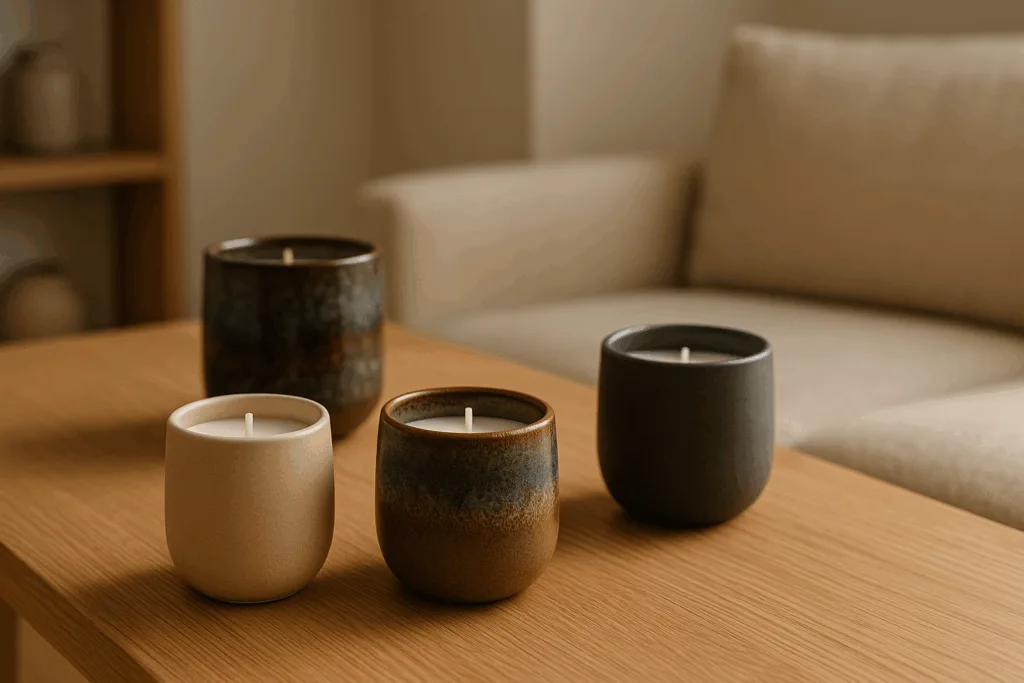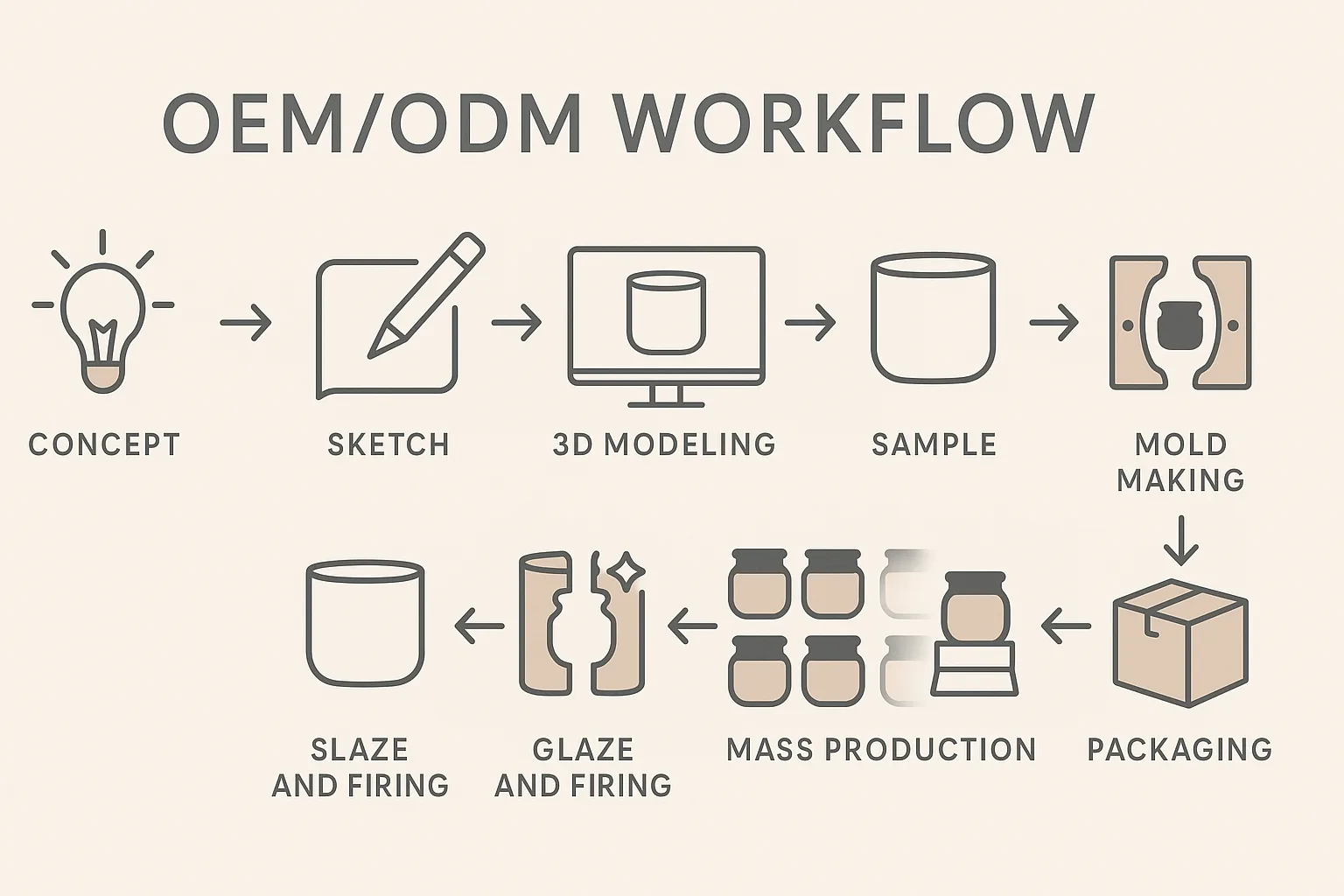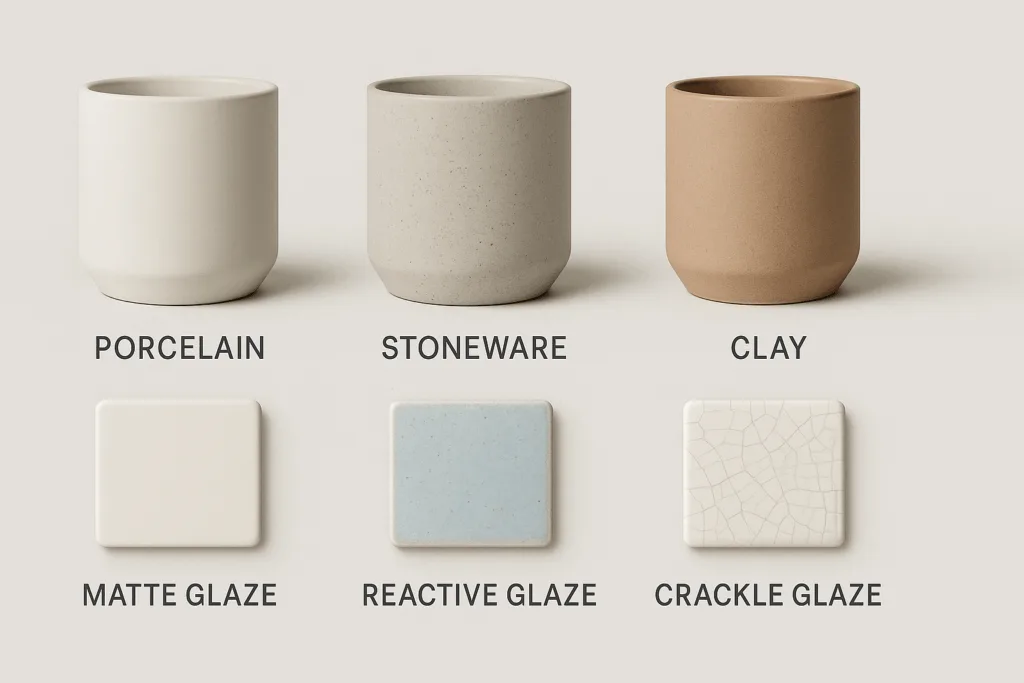The Rising Demand for Custom Ceramic Candle Jars in the Global Market
Ceramic candle jars have become one of the most desired packaging solutions among premium fragrance brands around the world. As consumer lifestyles shift toward wellness, interior aesthetics, and personal rituals, the demand for elegant, durable, and emotionally appealing candle vessels continues to rise. For B2B buyers, ceramic jars offer a unique blend of artistry and performance, creating a luxurious impression that elevates any candle line.
One major driver behind this demand is the growing focus on ambience at home. Post-pandemic habits have led people to spend more time indoors, curating warm and calming environments with natural textures, soft light, and rich fragrances. Ceramics align perfectly with this lifestyle, providing a handcrafted feeling no other material can replace.
Additionally, global consumers now favor products that blend beauty with longevity. Ceramic containers check all the boxes: they are reusable, heat-stable, elegant, and compatible with a wide range of wax types and scent intensities. This makes them a smart investment for brands aiming to position themselves in the mid-to-high-end market.
Ceramics also resonate especially well with wellness and spa brands. Their tactile surface, weight, and visual charm create a multi-sensory experience that strengthens the emotional value of the candle. Whether minimalist or richly glazed, each ceramic jar has a story—and modern consumers appreciate products that feel meaningful and authentic.
Industry Trends Shaping Modern Ceramic Candle Packaging
The candle industry is undergoing rapid transformation driven by lifestyle shifts, consumer consciousness, and global aesthetic trends. Ceramic jars sit at the intersection of these trends, benefiting from their timeless appeal.
Nature-Inspired Minimalism
There is a rising preference for organic shapes, soft matte finishes, and nature-inspired textures. Ceramic materials naturally lend themselves to these styles. Reactive glazes, unglazed stoneware, and clay-like finishes reflect the desire for grounded, earthy design.
Clean Fragrance Movement
As more consumers lean toward phthalate-free, plant-based, and non-toxic scent systems, brands are choosing packaging that reinforces their clean identity. Ceramic—being a stable, heat-resistant, and inert material—supports the narrative of purity.
Hybrid Lifestyle
The blend of working from home, intentional self-care routines, and micro-luxuries leads to candles being used daily. This encourages brands to choose durable and reusable jars, positioning ceramics as the premium choice.
Sustainability and Transparency in Ceramic Candle Jar Production
Sustainability is becoming a non-negotiable factor in product design. Ceramic vessels stand out due to their long lifespan and eco-friendly potential.
Eco-Friendly Glazes and Lead-Free Standards
High-quality ceramics use lead-free, cadmium-free glazes. As brands expand into the EU and U.S. markets, certifications such as LFGB, REACH, and CA65 become essential.
Transparent Sourcing
Buyers now expect transparency regarding clay origins, glaze composition, and firing processes. Ethical sourcing is a selling point for modern candle brands.
Sustainable Packaging
Given the weight of ceramic jars, protective yet sustainable packaging options are key. Many brands now opt for biodegradable inserts, recycled kraft boxes, and water-based printing.
Innovation and Scent-Tech in Modern Candle Manufacturing
Technology is transforming how brands design candles, especially when paired with ceramic jars.
AI-Assisted Scent Design
AI tools help create layered, complex scent profiles based on geographical preferences, seasonal demands, and emotional mapping.
Thermal Engineering
Ceramics maintain heat longer than glass, supporting a more stable burn curve and richer scent throw. Engineers now optimize jar thickness and shape to enhance fragrance diffusion.
Multi-Sensory Candle Concepts
Ceramic’s versatility enables combinations of texture, color, weight, and pattern—turning candles into multi-sensory art pieces.
MATERIAL SCIENCE & CONTAINER ANALYSIS — The Core of Ceramic Candle Quality
Material science affects every aspect of candle performance.
Density, Porosity, and Heat Resistance
High-density ceramics reduce sweating, cracking, and uneven burn. Proper firing temperatures (1200–1300°C) create durable, non-porous walls.
Glaze Chemistry
Glaze influences scent perception, durability, and colorfastness. Premium glazes resist staining, withstand heat, and maintain vibrant color over time.
Material Origins
Different regions produce vastly different ceramic qualities:
- Jingdezhen: fine porcelain, ultra-smooth surfaces
- Dehua: warm-toned white clay, ideal for luxury goods
- Northern China Kilns: earthy stoneware with organic textures
Market Positioning
Material provenance enhances brand storytelling—key to Western B2B customers seeking differentiation.
B2B Suitability
Engraving, decal application, relief patterns, and kiln-stable pigments allow ceramic jars to support high-end branding.
Ceramic vs. Glass vs. Metal Candle Jars
Each material has pros and cons.
Heat Conductivity
Ceramics retain heat longest, offering a more even burn.
Scent Throw
Ceramic’s heat stability means consistent scent diffusion throughout the burn.
Market Positioning
- Glass: mass market
- Metal: travel and tin candles
- Ceramic: boutique, luxury, design-forward brands
Global Scent Preferences and How Ceramic Influences Perception
Ceramics elevate fragrance in different ways depending on the region.
North America
Prefers clean, cozy, and comforting scents—ceramic jars reflect this aesthetic.
Europe
Values craftsmanship, sustainability, and heritage design.
Oceania
Emphasizes natural, botanical, and coastal themes that pair well with matte ceramics.
Design Considerations When Customizing Ceramic Candle Jars
Key factors influence the cost, appearance, and burn performance.
Shape and Volume
Thick-walled vessels support stable heating.
Glaze Options
Matte, glossy, crackle glaze, and reactive glazes each create unique visual effects.
Decorative Techniques
Embossing, engraving, decals, and relief patterns elevate brand identity.
Understanding the MOQ for Ceramic Candle Jars (1000+ Minimum)
One of the most important topics for B2B buyers: refined, beautifully crafted ceramic jars require a minimum order quantity of 1000 pieces.
This is not only industry standard—it is already a very friendly and low MOQ considering the craftsmanship and production steps involved.
Why 1000+ MOQ?
- High-temperature kilns require batch efficiency
- Mold creation and glaze matching are costly
- Firing loss (5–10%) must be accounted for
- Color consistency requires larger batches
How MOQ Affects Quality
Increasing order size improves color stability, reduces defects, and optimizes cost.
OEM/ODM Workflow for Custom Ceramic Candle Jars
The complete process from idea to finished product:
Step 1: Concept & Sketch
Step 2: 3D Modeling
Step 3: Sample Creation
Step 4: Mold Production
Step 5: Firing & Glazing
Step 6: Mass Production (1000+ MOQ)
Step 7: Quality Inspection
Step 8: Packaging & Logistics
Private Label Opportunities with Ceramic Candle Collections
Ceramic jars are ideal for:
- Seasonal collections
- Hotel and spa collaborations
- Boutique retail sets
Logistics & Global Shipping Considerations
Ceramic’s weight makes professional logistics essential.
FOB, EXW, DDP Options
Protective Packaging
Cost Optimization for Heavy Goods
Sustainability Advantages of Ceramic Containers
Ceramics last for years and can be reused as planters, storage containers, or décor pieces.
Pricing Structure for Custom Ceramic Candle Jars
Costs depend on:
- Clay type
- Glaze
- Size and thickness
- Decoration
- Mold fees
Higher quantities (3000+, 5000+) significantly reduce unit cost.
How Circe Home Ensures Premium Quality
Circe Home blends technical precision with artisanal design.
Expert Material Selection
Glaze Stability Testing
Tech + Craft Manufacturing Philosophy
Final Buying Checklist
- Material
- Glaze
- Thickness
- MOQ 1000+
- Packaging
- Certifications
Conclusion
Custom ceramic candle jars blend craftsmanship, durability, and refined aesthetics—making them one of the most powerful tools for brands aiming to elevate their candle collections. From material science to glaze selection, from MOQ requirements to global design trends, every detail shapes the final product’s performance and market value. For professional B2B buyers, understanding these factors ensures smoother production, stronger branding, and long-term consumer appeal.
As the demand for premium home fragrance continues to grow, ceramic jars offer not only beauty but strategic business advantages. With the right manufacturing partner and a clear understanding of design and technical considerations, your next ceramic candle collection can stand out globally and build lasting customer loyalty.



